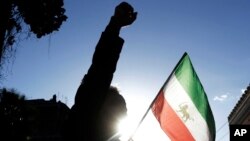Iran’s leaders appear to be divided about the reasons behind the anti-government protests roiling the country, who the demonstrators are and how to curtail the unrest - the most significant challenge to Iran’s clerical leadership since 2009, when authorities resorted to a nationwide crackdown to crush the pro-democracy "green movement."
Supreme Leader Ayatollah Ali Khamenei accused foreign enemies Tuesday of fomenting the demonstrations, which have seen police stations and the offices of Friday prayer leaders attacked. The building of the Justice Ministry was set on fire in the town of Karaj, and in Arak, the governor’s office was occupied.
On his official website, Khamenei wrote, "In recent days, enemies of Iran used different tools including cash, weapons, politics and intelligence apparatus to create troubles for the Islamic Republic."
His aides have singled out the United States, Britain and Saudi Arabia as the culprits.
Other senior Iranian officials, however, have downplayed the alleged role of foreign powers in the protests that began in Mashhad, Iran’s second-largest city, and quickly spread. On Saturday, the protests reached the capital, Tehran, which saw clashes between protesters and riot police around the main university.
Reformist President Hassan Rouhani has identified economic despair as the underpinning of the unrest. “We have no bigger challenge than unemployment. Our economy requires major corrective surgery,” Rouhani acknowledged Monday.
Deputy Interior Minister Hossein Zolfaghari noted Tuesday that 90 percent of the more than 450 protesters arrested so far were under the age of 25, and he indicated they were expressing frustration about economic woes. Silent at first on the unrest, the state-owned Islamic Republic of Iran Broadcasting has followed the reformists’ explanation for the burgeoning trouble, citing economic problems as the root cause of the confrontations that are turning increasingly deadly.
Hardliners who want to launch the kind of security crackdown that crushed the 2009 unrest dismiss the reformist line.
“If people came into the streets over high prices, they should not have chanted those [anti-government] slogans and burned public property and cars,” Gen. Esmail Kowsari told a state-owned media outlet Sunday.
Kowsari is a conservative politician and currently the deputy chief of an Islamic Revolutionary Guards unit responsible for maintaining security in Tehran. So far, the government has not heeded his warnings about using an "iron fist" to crush the protesters.
The latest unrest, which is on a smaller scale than that of 2009, say analysts, is being dealt with more cautiously, with authorities instead containing protests locally as they occur, without the mass deployment of Revolutionary Guards units.
Zolfaghari predicted Tuesday the protests would be short-lived, saying security forces “decisively countered the saboteurs” who resorted to violence. “In most parts of the country, the situation is now normal and the unrest that took place in certain areas will soon end with the people's cooperation and the efforts of security forces,” Zolfaghari said
Ghasem Sholeh-Saadi, a human rights activist and former Iranian lawmaker who is now an international law professor at the University of Tehran, thinks the protests have the potential to go much further. “Things are getting out of hand,” he told the news site IranWire, a joint venture comprising a group of exiled Iranian journalists.
“I believe that this will continue because the government cannot satisfy people’s demands and, with the present structure, our rulers are not ready for change. For the moment, we are at a political impasse,” Sholeh-Saadi said.
He argues the government “has no effective means to suppress [the people] and, even if it could, cracking down would not solve their problem.” The threat, he says, isn’t just to the hardliners, but the reformists as well, who have been left behind by the people as their demands become more cohesive and more sweeping.
“The accumulation of unmet demands, the complicated economic issues and the security atmosphere has made it so that in only three days and with unbelievable speed, the slogans have turned radical and are voicing open opposition to Mr. Khamenei and Mr. Rouhani,” he said.
A former British ambassador to Iran, Richard Dalton, agrees that even though price increases for key commodities sparked the protests, the unrest has developed into “a reflection of deep discontent with the nature of the Islamic regime.” It has been fueled by despair, he says, among ordinary Iranians, who are angry that their lives have not improved since Rouhani struck a 2015 nuclear deal with foreign powers, which resulted in the lifting of some economic sanctions on the country.
Rouhani had promised the nuclear deal would usher in a more successful economy, with all enjoying the benefits. Dalton says the Iranian authorities appear surprised by how widespread the protests have become. “It confirms once again a significant section of the population wants to see fundamental change,” he said.
The former envoy, however, suspects that the protests aren’t the beginning of an Arab spring-type uprising - predicting the demonstrations will run their course as most Iranians, want “evolution, not revolution,” he says. Dalton concedes, though, that isn’t the only possible course of events.
















